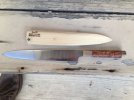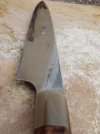- Joined
- Oct 3, 2002
- Messages
- 12,297
Mike, your 'normalizing' is a bit different than mine. After forging I'll heat to not magnetic in the forge and let air cool three times, lowering the heat a little each time.
Ya might want to try 61-62 Rc on a blade and test it hard. I think you might like it.
But hell, I have one of your W2 knives and it is FINE!!!
Ya might want to try 61-62 Rc on a blade and test it hard. I think you might like it.
But hell, I have one of your W2 knives and it is FINE!!!


